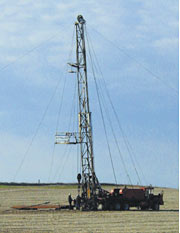 |

|
| |
Strong,
Effective, Fair Enforcement... Emphasis Programs |
|
| |
OSHA has six national emphasis programs (NEPs): amputations, lead, nursing
and personal care facilities, shipbreaking, silica, and trenching
and excavation.
What isn't as well known or
recognized is that the agency's regional and area offices
operate about 135 local emphasis programs (LEPs), developed and
conducted locally to address specific regional hazards or high-hazard
industries.
Some programs, like the food processing LEP run by OSHA's
Buffalo and Syracuse Area Offices, tailor NEPs to local needs. Others,
such as the oil and gas industry LEPs at OSHA's Corpus Christi,
Lubbock, and El Paso Area Offices, increase emphasis on local industries
or hazards.
Like their national counterparts, LEPs put heavy emphasis on outreach
and education. Compliance officers work with local employers, educating
them about the hazards being addressed and ways to reduce or eliminate
them. Only after this initial outreach is finished do compliance
officers begin random, unannounced LEP inspections.
The success stories behind these LEPs could fill volumes. Here are
four examples of the positive change these programs are creating.

OSHA's Wichita Area Office inspected oil drilling operations, oil
well services, and workover rigs like the one pictured to
help reduce fatalities.
|
Concord Area Office: Ergonomics
Dave May, director for OSHA's Concord Area Office, is a firm
believer that LEPs are making a difference in workplace safety and
health. His office ran an LEP on ergonomics from 1992 to 1995.
The office's compliance officers conducted
19 inspections at sites of 14 New Hampshire employers with multiple
workers' compensation claims involving carpal tunnel syndrome
and tendonitis. The compliance safety and health officers who visited
the sites identified ergonomic stressors and suggested feasible
controls, and, as appropriate, issued citations.
As a result, carpal tunnel syndrome claims dropped significantly
among these employers. Their worksites accounted for 17 percent
of all carpal tunnel syndrome claims in New Hampshire in 1992, but
less than 5 percent by 1997-a rate that continued through
1999. Overall, the incidence rate of carpal tunnel syndrome at these
employers' worksites dropped by 90 percent during this period.
Wichita Area Office: Oil Fields
Historically, the Kansas oil and gas extraction industry has had
a high fatality incident rate, accounting for 15 percent of all
work-related fatalities in the state. In 1995, when the number of
workers killed in oil and gas extraction operations spiked to six,
OSHA's Wichita Area Office launched a problem-solving initiative,
which included a local emphasis program to eliminate hazards in
the industry. According to Area Office Director Judy Freeman, the
office approached the problem on two fronts. In addition to kicking
off an aggressive inspection program, the group formed a partnership
with the Kansas Independent Oil and Gas Association to provide training,
disseminate information on fatalities, and encourage voluntary compliance.
The Engineering Extension Service of Texas A&M University developed
a petroleum safety training program based on training needs identified
by the Wichita Area Office. After extensive outreach and training,
the office initiated LEP inspections. All employers inspected under
the LEP said they improved their safety and health programs in response
to the outreach efforts, and 50 percent of the inspections resulted
in no violations observed. Only three employers had more than one
serious violation, and all employers who received citations entered
into OSHA settlement agreements that included a commitment of improving
their safety and health programs. In the two years after the initiative
began, the state's oil and gas industry experienced no fatalities.
Boston Regional Office: Fall Protection
Another successful LEP, coordinated by OSHA's Boston Regional
Office, is bucking the national trend and causing a steady decline
in fatal falls in the region. The region put the LEP into effect
in April 1999 in response to yearly increases in the number of workers
who had fallen to their deaths, regionally as well as nationally.
The program began with extensive outreach activities to inform employers
and employees about the LEP and to raise their awareness of common
fall hazards, employer compliance responsibilities, and possible
abatement approaches. In addition, the program targets specific
construction sites based on referrals, usually from OSHA compliance
officers, and also calls on inspectors to put greater emphasis on
fall hazards during general industry inspections. According to Robert
Hooper, assistant regional administrator for federal-state operations,
the numbers show that the effort is working. In 1999, fatal falls
in the region numbered 20; in 2000, 15; in 2001, 12; and by the
end of November 2002, nine.
Bellevue Area Office: Commercial Diving
Similarly, OSHA's Bellevue Area Office, in partnership with
state regulatory agencies, initiated an LEP in 1990 following a
series of incidents on Puget Sound in which commercial divers died
while harvesting shellfish, sea urchins, and sea cucumbers.
According to Dean Ikeda, assistant regional administrator for federal-state
operations at the Seattle Regional Office, OSHA compliance safety
and health officers began inspecting commercial seafood harvesting
operations, identifying hazards that contribute to serious injury
and death and compelling employers to take corrective actions.
Some of the more common violations involved lack of proper diver
training and experience, inadequate or defective equipment, and
deficiencies in conducting and monitoring dive operations. As a
result, no diving-related fatalities occurred in Washington waters
between May 1990 and November 1995.
In late 1995, shortly after Native American tribes began harvesting
Washington waters commercially, two tribal divers died in separate
diving-related incidents, and a third was seriously injured. The
divers involved had little or no dive training and experience. In
response, the Bellevue Area Office refocused its enforcement and
outreach activities to target the tribes, and no other incidents
occurred.
The office continued its LEP through 2001, declaring it a success
after inspections showed high levels of compliance with OSHA's
diving standard. As a result, the office conducted no commercial
diving inspections last year, but is committed to reinstating the
LEP in the unlikely event of a resurgence in dive mishaps or complaints.
JSHQ
|
|
|
|
